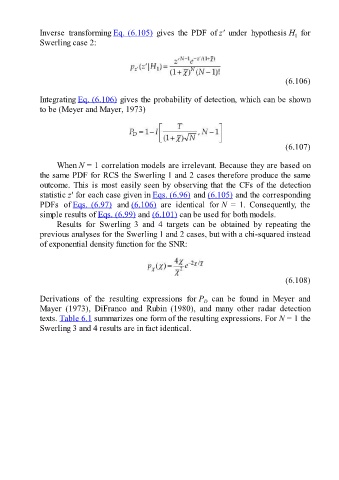Page 487 - Fundamentals of Radar Signal Processing
P. 487
Inverse transforming Eq. (6.105) gives the PDF of z′ under hypothesis H for
1
Swerling case 2:
(6.106)
Integrating Eq. (6.106) gives the probability of detection, which can be shown
to be (Meyer and Mayer, 1973)
(6.107)
When N = 1 correlation models are irrelevant. Because they are based on
the same PDF for RCS the Swerling 1 and 2 cases therefore produce the same
outcome. This is most easily seen by observing that the CFs of the detection
statistic z′ for each case given in Eqs. (6.96) and (6.105) and the corresponding
PDFs of Eqs. (6.97) and (6.106) are identical for N = 1. Consequently, the
simple results of Eqs. (6.99) and (6.101) can be used for both models.
Results for Swerling 3 and 4 targets can be obtained by repeating the
previous analyses for the Swerling 1 and 2 cases, but with a chi-squared instead
of exponential density function for the SNR:
(6.108)
Derivations of the resulting expressions for P can be found in Meyer and
D
Mayer (1973), DiFranco and Rubin (1980), and many other radar detection
texts. Table 6.1 summarizes one form of the resulting expressions. For N = 1 the
Swerling 3 and 4 results are in fact identical.

